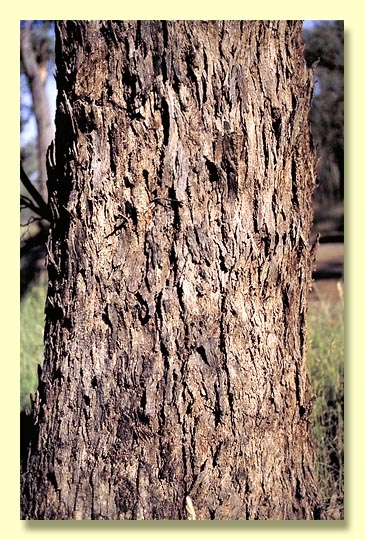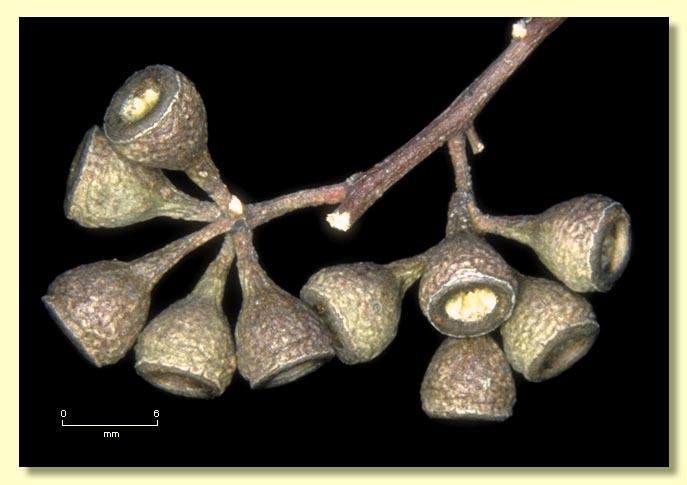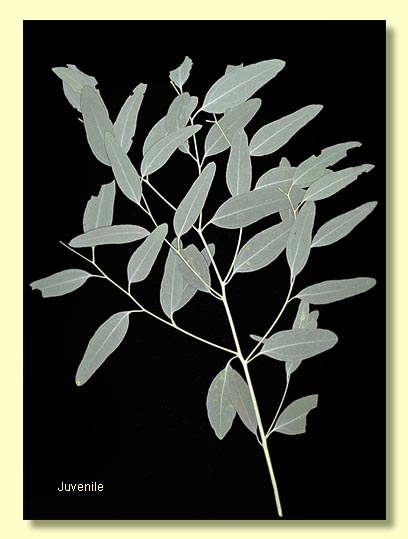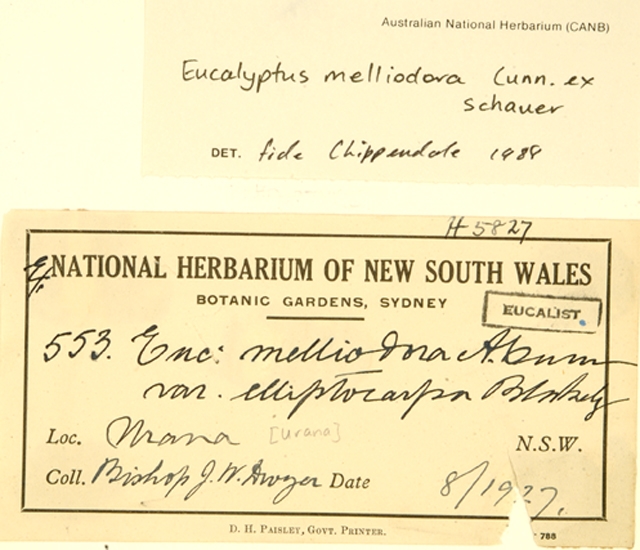Euclid - Online edition
Eucalyptus melliodora
Eucalyptus | Symphyomyrtus | Adnataria | Terminales | Melliodorae | Leucoxylon
T: Bathurst neighbourhood, NSW, Nov. 1825, A.Cunningham 57; iso: E, G, K, MEL, NSW.
Eucalyptus patentiflora Miq., Ned. Kruidk, Arch, 4: 125 (1856). T: Melbourne, Vic., F.Mueller; syn; St Kilda, Vic., F. Mueller s.n. ; syn: K.
Eucalyptus caerulescens Naudin, Descr. Emploi Eucalyptus introd. Europe 47 (1891). T: cultivated Bois du Boulogne, Algeria, 14 Feb. 1883, C.Naudin s.n.; Thuret, Nov. 1889, C.Naudin s.n.; fide J.H.Maiden, Crit. Revis. Eucalyptus 2: 136 (1912); (P).
Eucalyptus forsythii Maiden, Crit. Revis. Eucalyptus 6: 115 (1922). T: Pilliga Scrub, Coonabarabran-Baradine road, NSW, Oct. 1899, W.Forsyth s.n.; holo: NSW; iso: CANB.
Eucalyptus melliodora var. elliptocarpa Blakely, loc. cit. T: Urana, NSW, Aug. 1927, J.W.Dwyer s.n.; holo: NSW; iso: CANB.
Bark fibrous or thin flakes held in variable amounts on trunk, sometime entire trunk rough, yellow-brown to yellow-grey; smooth bark pale grey to yellow; branchlets usually non-glaucous.
Juvenile growth (coppice or field seedlings to 50 cm): stem rounded in cross-section; juvenile leaves always petiolate, opposite for several pairs then alternate, lanceolate to elliptical, 2.5–6.5 cm long, 0.9–3.5 cm wide, green to grey-green, usually non-glaucous. Crowns grey or green.
Adult leaves alternate, petiole 0.8–2 cm long; blade slightly falcate to lanceolate to ovate, 6–14 cm long, (0.6)0.8–3 cm wide, base tapering to petiole, concolorous, dull, green to grey-green or grey, side-veins at an acute or wider angle to midrib, densely to very densely reticulate, intramarginal vein parallel to and well removed from margin (sometimes doubled), oil glands island and intersectional.
Inflorescence axillary unbranched, peduncles 0.3–1 cm long, buds 7 per umbel, pedicels 0.2–1 cm long. Mature buds clavate to ovoid to diamond-shaped, 0.4–0.8 cm long, 0.3–0.5 cm wide, green to yellow or creamy, scar absent, operculum conical to rounded or beaked, stamens inflexed, with outer staminodes, anthers adnate, positioned obliquely at filament tip, cuboid, dehiscing by terminal pores, style long, stigma pin-head shaped, locules 4 or 5, the placentae each with 4 vertical ovule rows. Flowers white.
Fruit on pedicels 0.1–0.9 cm long, hemispherical or truncate-globose, 0.3–0.8 cm long, 0.3–0.7 cm wide, staminophore broad and usually deciduous, disc descending, valves 4 or 5, near rim level or enclosed.
Seeds brown, reddish brown or grey, 1.5–2.5 mm long, flattened-ovoid, dorsal surface reticulate, hilum ventral.
Cultivated seedlings (measured at ca node 10): cotyledons reniform to oblong; stems square in cross-section; leaves petiolate, opposite for 4 or 5 pairs, ovate-elliptic, 4–8 cm long, 1.5–5 cm wide, base tapering, margin entire, grey-green to green.
Flowering has been recorded in January, February, May, June, July, August, September, October, November and December.
A small to tall tree widespread in Victoria from the Western District and Grampians east to the Snowy River and north through the tablelands, western slopes and some lower montane areas of the South Coast region of New South Wales and extending into Queensland through the Darling Downs as far as the Consuelo Tableland and Kroombit Tops. It occurs on light to heavy alluvial soils in broad valleys but also on slopes and sometimes ridgetops. It usually has fairly loose, fibrous, yellowish brown rough bark which can vary from covering the butt only to covering the whole trunk. Smooth bark varies from yellow to greyish white. Crown leaves are variable in colour from greyish to blue-green and green, sometimes slightly waxy, always dull, and surprisingly variable in width within a single stand. Eucalyptus melliodora is distinguished from other box species within its geographic area of occurrence by the buds borne in axillary clusters of 7, the retention of the outer operculum until flowering, the sterile outer stamens and barrel-shaped fruit. It is related to and sometimes resembles E. leucoxylon, which has larger buds and fruit in 3s and by usually larger adult leaves. Also the juvenile leaves of E. melliodora are petiolate and alternate, not sessile and opposite as in E. leucoxylon. Both have fruit with four or five valves and a conspicuous staminal ring left on the top of the fruit after flowering. The bark of E. melliodora may sometimes be very thick and dark showing perhaps its relationship with E. sideroxylon which has black ironbark and larger, often pendulous buds and fruit.
The two species are known to hybridize around Pilliga.
Eucalyptus melliodora belongs in Eucalyptus subgenus Symphyomyrtus section Adnataria because the buds have two opercula, ovules are in four rows, seeds are flattened-ovoid, cotyledons are reniform, and anthers are rigid on the staminal filaments. Within section Adnataria, E. melliodora is part of a small subgroup, series Melliodorae, further characterised by having buds in axillary clusters, the outer operculum being retained until flowering when both opercula are shed together, and the flowers having outer stamens that are sterile whilst inner stamens are fertile, and a broad staminal ring that can often be seen on the fuit but ultimately is deciduous. Other species in series Melliodorae are the smooth-barked E. petiolaris, endemic to the Eyre Peninsula; E. leucoxylon, common in Victoria and eastern South Australia; and the two ironbarks, E. sideroxylon and E. tricarpa, from New South Wales and Victoria. Another more distantly related box species from coastal and sub-coastal south-eastern Australia, E. bosistoana, is sometimes confused with E. melliodora, but differs in having all stamens fertile and inflorescences usually terminal to the branches, not axillary.



















